Philippines
Welcome to Philippines
Afghanistan, a land of rugged mountains, ancient history, and rich cultural heritage, is gradually re-emerging as a destination for adventurous travelers in 2025. Despite decades of conflict, the country offers unique experiences for those willing to explore its breathtaking landscapes, historic sites, and vibrant bazaars. With careful planning and respect for local customs, visitors can discover a side of Afghanistan few outsiders have seen.
The country’s rich history is shaped by a blend of indigenous, Malay, Spanish, American, and Asian influences, reflected in its architecture, festivals, cuisine, and the daily lives of its friendly people. From the bustling metropolis of Manila, with its 16th-century Spanish colonial landmarks and modern shopping malls, to the tranquil, off-the-beaten-path islands like Siquijor and Romblon, the Philippines offers a wide range of experiences for every traveler. Whether you seek adventure, cultural immersion, or pure relaxation, the Philippines promises unforgettable memories with its breathtaking landscapes and welcoming locals.
1.
Diverse Natural Wonders: The Philippines is home to some of the world’s most beautiful beaches, vibrant coral reefs, and unique ecosystems. Iconic destinations such as Palawan’s El Nido, the Chocolate Hills of Bohol, and the surfing paradise of Siargao offer spectacular scenery and outdoor activities like snorkeling, diving, hiking, and island hopping.
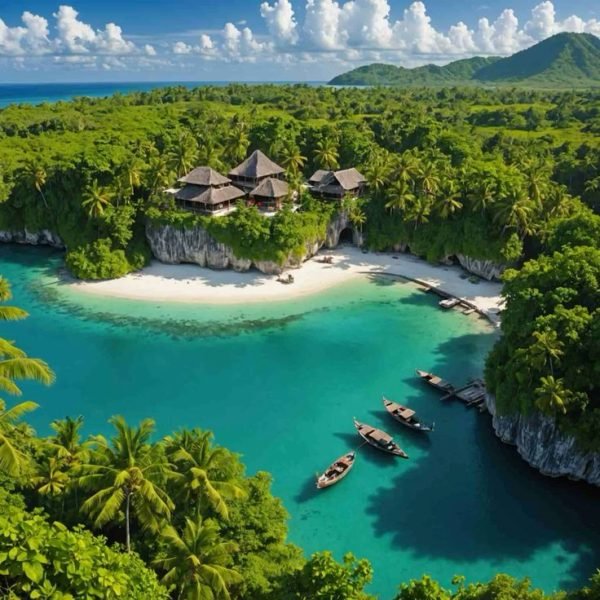
2.
Rich Cultural Heritage and Warm Hospitality: The country’s complex history and multicultural heritage create a fascinating cultural tapestry. Visitors can explore Spanish colonial towns like Vigan, experience colorful festivals such as Sinulog in Cebu, and enjoy traditional Filipino hospitality, which makes travelers feel instantly welcome.

Planning Your Trip
Visa Information
Most travelers can enter the Philippines visa-free for stays ranging from 14 to 30 days, depending on their nationality. For longer visits or specific purposes such as work or study, a visa must be obtained in advance. It is advisable to check the latest visa requirements from official sources before traveling, as policies may change.
Best Time to Visit
The ideal time to visit the Philippines is during the dry season, from November to April, when sunny weather prevails across the islands, perfect for beach activities and island hopping. This period avoids the typhoon season, which typically occurs from June to October and can bring heavy rains and storms. For travelers seeking fewer crowds and potential cost savings, the shoulder months of May-June and September-October can also be considered, though weather conditions may be less predictable.
Getting To and Around
Getting to the Philippines
The main international gateway is Ninoy Aquino International Airport (MNL) in Manila, which connects the country to major cities worldwide. Other international airports include Mactan-Cebu, Clark, and Kalibo, serving different regions and islands. Flights from Asia, the Middle East, and the Pacific are frequent and well-served.
Getting Around
Traveling within the Philippines involves a mix of transportation modes:
- Domestic Flights: Given the vast number of islands, flying is often the fastest way to travel between major destinations like Manila, Cebu, Palawan, and Mindanao.
- Ferries and Boats: Island hopping is a highlight of any Philippine trip. Ferries and boats connect many islands, though schedules can vary.
- Jeepneys and Tricycles: These colorful, iconic vehicles are the most common form of local transport in towns and cities. Jeepneys are especially popular for short to medium distances and offer a vibrant cultural experience.
- Ride-Hailing Apps: Services like Grab provide convenient taxi and car rides in urban areas, offering a safer and more comfortable alternative to public transport.
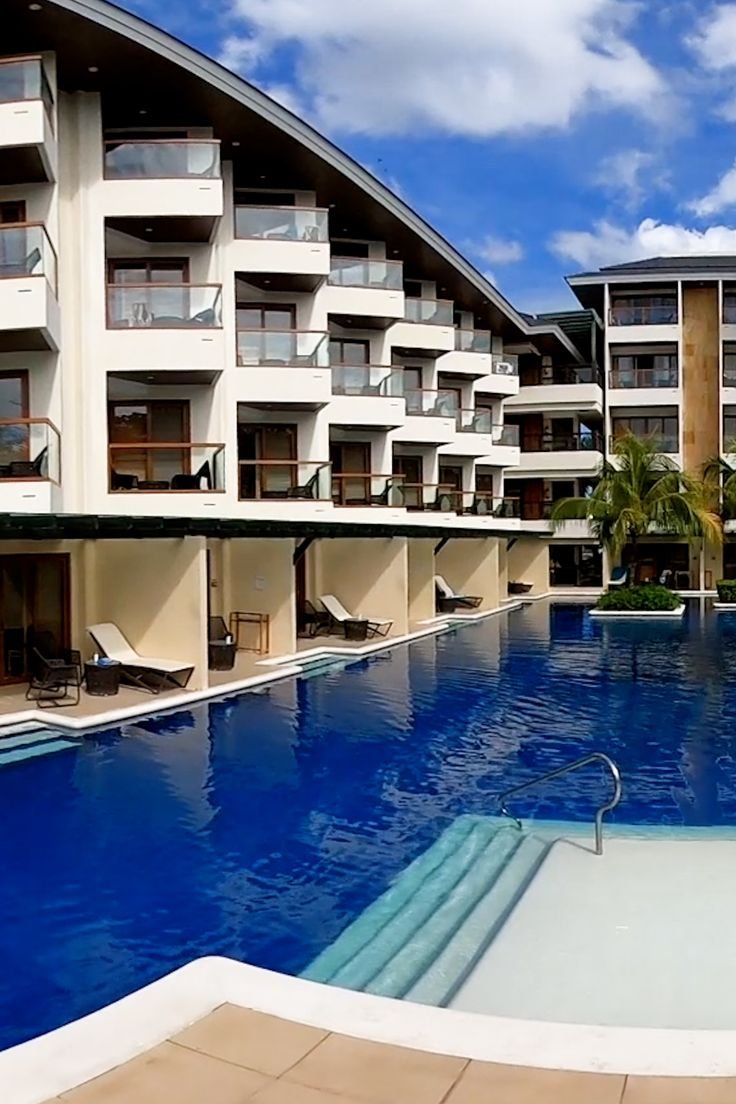
Accommodation
The Philippines offers a wide variety of accommodation options to suit all budgets and preferences, ranging from budget hostels and guesthouses to luxury resorts and unique glamping experiences. Whether you are a backpacker, a family traveler, or someone seeking upscale comfort, the archipelago has something for everyone.
Accommodation Options
Types of Accommodation
- Hostels and Budget Hotels: Ideal for backpackers and budget travelers, hostels are plentiful in major tourist hubs like Manila, Cebu, and Siargao. They provide affordable dormitory-style or private rooms with communal spaces that encourage socializing. Examples include Happiness Hostel in Manila and Lexias Hostel in Siargao.
- Mid-Range Hotels and Resorts: These offer a balance of comfort and affordability with amenities such as swimming pools, restaurants, and air-conditioned rooms. Popular mid-range options include Armada Hotel Manila and Bayview Park Hotel Manila, which are well-located and provide good service.
- Luxury Hotels and Resorts: For travelers seeking indulgence, the Philippines boasts world-class resorts and hotels. Shangri-La Boracay and Sofitel Philippine Plaza Manila are among the top luxury choices, offering beachfront locations, spa services, fine dining, and elegant rooms.
- Unique Stays – Glamping and Beach Huts: For a more immersive nature experience, glamping resorts like Nacpan Beach Glamping and Solina Beach & Nature Resort provide comfortable tents or cabins close to nature without sacrificing comfort. Traditional beach huts and eco-resorts are also popular in remote islands.
- Condominiums and Apartments: For longer stays or those who prefer a home-like environment, furnished condos and apartments are available in cities like Manila and Cebu. These often come with kitchen facilities and are located in business districts or near shopping centers.
- Capsule Hotels: A modern and budget-friendly option, capsule hotels like BMAX Spacepods and Attic Capsule Hotel offer compact, private pods with essential amenities, ideal for solo travelers or short stays.
Popular Areas to Stay
- Manila: The capital offers a wide range of accommodations from budget hostels to luxury hotels like The Manila Hotel and Diamond Hotel Philippines. It’s a good base for city exploration and business travel.
- Cebu: Known as the Queen City of the South, Cebu has everything from affordable guesthouses to upscale resorts. Holiday Inn Cebu City is highly recommended for its service and location.
- Boracay and Palawan: These islands are famous for their stunning beaches and have numerous resorts, from budget to luxury, catering to beach lovers and adventure seekers.
- Siargao: The surfing capital offers hostels, mid-range hotels, and luxury resorts, making it accessible for all types of travelers.
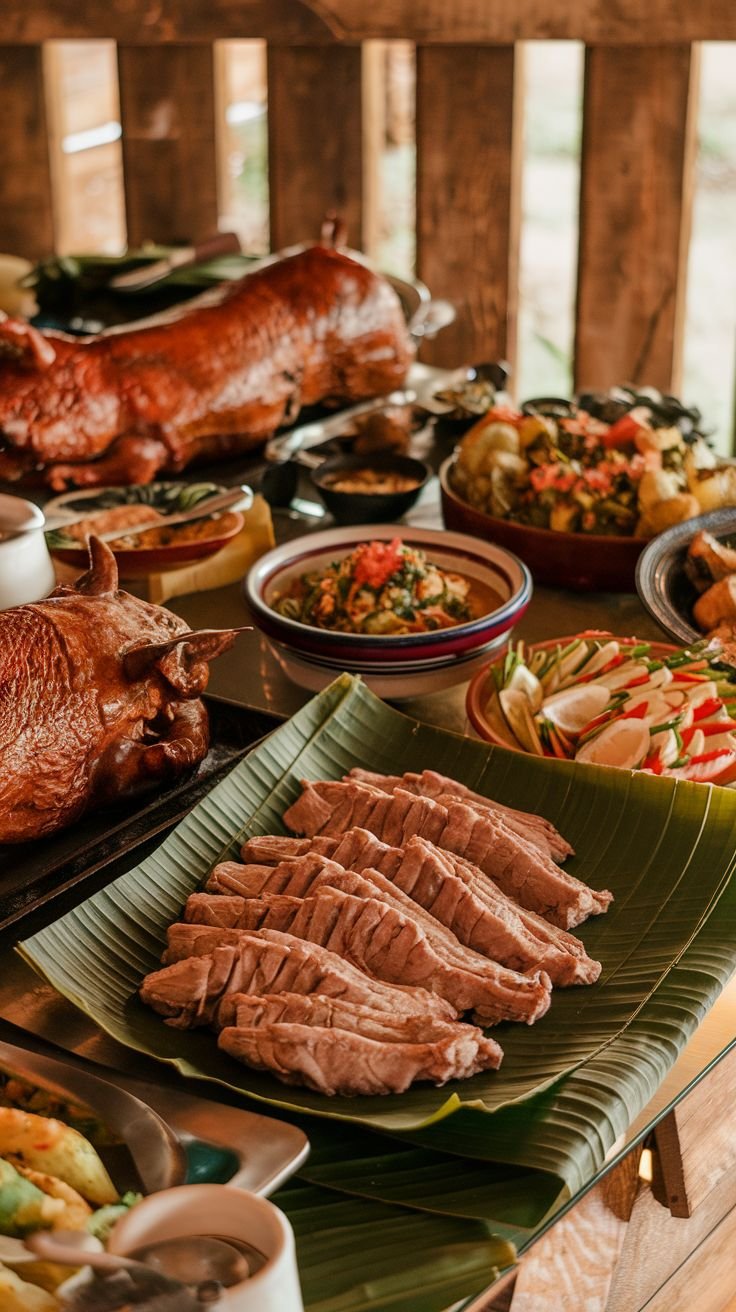
Food and Drink
The Philippines is a culinary treasure trove, blending indigenous flavors with Spanish, Chinese, American, and other Asian influences. Filipino cuisine is characterized by bold, savory, and often tangy flavors, with a strong emphasis on fresh ingredients and communal dining.
Must-Try Filipino Dishes
- Adobo: Often considered the national dish, adobo is meat (usually chicken or pork) marinated and simmered in vinegar, soy sauce, garlic, and spices, resulting in a rich, tangy, and savory stew.
- Sinigang: A sour soup made with tamarind, tomatoes, and various vegetables, usually cooked with pork, shrimp, or fish. It’s refreshing and perfect for the tropical climate.
- Lechon: Whole roasted pig with crispy skin and succulent meat, often served during festivals and special occasions. Cebu is particularly famous for its lechon.
- Pancit: A variety of noodle dishes, such as Pancit Canton (stir-fried noodles) and Pancit Malabon (seafood noodles), are staples at celebrations and everyday meals.
- Kare-Kare: A peanut-based stew with oxtail, tripe, and vegetables, served with shrimp paste on the side for added flavor.
- Halo-Halo: The quintessential Filipino dessert, a colorful mix of shaved ice, sweet beans, fruits, jellies, and topped with leche flan or ice cream, perfect for cooling down in the tropical heat.
Popular Filipino Snacks and Street Food
- Balut: A fertilized duck egg boiled and eaten in the shell, a daring delicacy for adventurous eaters.
- Isaw: Grilled chicken or pork intestines, skewered and often sold by street vendors.
- Turon: Fried banana spring rolls coated with caramelized sugar, a sweet and crunchy treat.
Drinks to Enjoy
- Barako Coffee: A strong, bold coffee variety native to the Philippines, especially popular in Batangas.
- Buko Juice: Fresh coconut water served straight from the coconut, hydrating and refreshing.
- San Miguel Beer: The country’s most famous beer brand, widely available and enjoyed by locals and tourists alike.
- Tropical Fruit Shakes: Made from mango, pineapple, watermelon, and other local fruits, these shakes are a delicious way to beat the heat.
Dining Experience
Filipino dining is often a communal affair, with dishes shared among family or friends. Many restaurants offer “boodle fights,” a traditional military-style feast where food is spread on banana leaves and everyone eats with their hands. Street food markets and night markets provide an authentic taste of local flavors and lively atmosphere.
Where to Eat
- Fine Dining: Cities like Manila and Cebu have upscale restaurants serving modern Filipino cuisine and international dishes.
- Local Eateries (Carinderias): Small, affordable eateries serving home-cooked Filipino meals, perfect for budget travelers seeking authentic flavors.
- Food Markets and Night Bazaars: Great places to sample a variety of street foods and local specialties in a vibrant setting.
- Beachfront Restaurants: Islands such as Boracay, Palawan, and Siargao offer fresh seafood and tropical dishes with stunning ocean views.
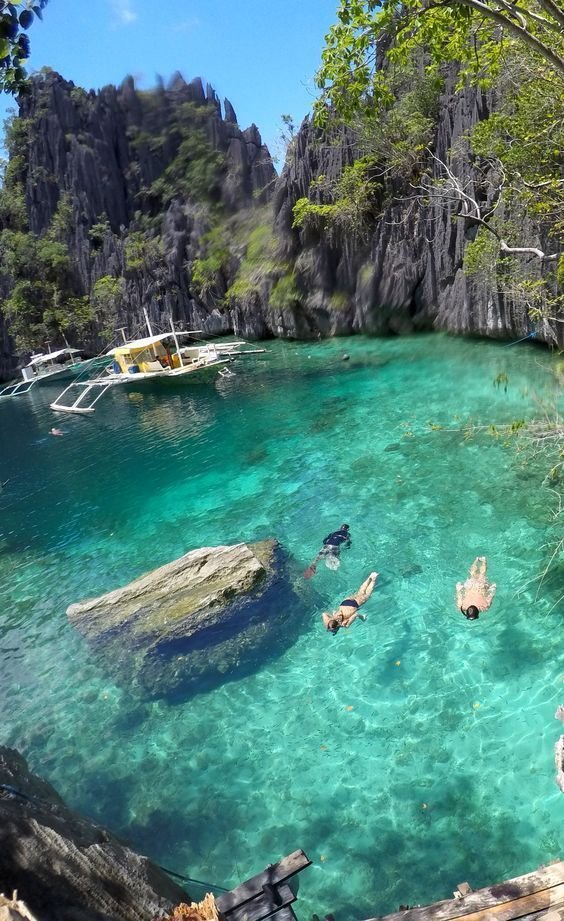
Must-See Attractions
The Philippines is a treasure trove of natural wonders, historical landmarks, and vibrant cultural sites. Whether you are drawn to pristine beaches, ancient rice terraces, or colonial architecture, the country offers a diverse range of must-see attractions that promise unforgettable experiences.
- Boracay Island
Boracay remains one of the most iconic destinations in the Philippines, famous for its powdery white sand beaches and crystal-clear turquoise waters. White Beach, the island’s main stretch, is perfect for swimming, sunbathing, and water sports such as kiteboarding and parasailing. Beyond the beach, Boracay boasts a lively nightlife with beachfront bars and restaurants, making it ideal for both relaxation and entertainment.
- Palawan – The Last Frontier
Palawan is often hailed as the crown jewel of Philippine islands. It features stunning limestone cliffs, secret lagoons, and some of the clearest waters in the world. El Nido, a highlight of Palawan, offers breathtaking island hopping tours through its dramatic lagoons like the Big Lagoon and Small Lagoon. Puerto Princesa’s Underground River, a UNESCO World Heritage Site, invites visitors to explore a spectacular subterranean river system inside a cave.
- Banaue Rice Terraces
Dubbed the “Eighth Wonder of the World,” the Banaue Rice Terraces are an extraordinary feat of ancient engineering carved into the mountains by the Ifugao people over 2,000 years ago. Trekking through these terraces offers a glimpse into indigenous culture and breathtaking panoramic views. The terraces are a UNESCO World Heritage Site and a must-visit for nature lovers and history enthusiasts alike.
- Chocolate Hills, Bohol
The Chocolate Hills are a unique geological formation consisting of over 1,200 symmetrical, grass-covered mounds that turn brown during the dry season, resembling giant chocolate drops. Visitors can climb viewing decks such as the Chocolate Hills Complex or Sagbayan Peak to enjoy sweeping 360-degree views. Bohol also offers other attractions like the tarsier sanctuary and beautiful beaches.
- Intramuros, Manila
Step back in time by visiting Intramuros, the historic walled city in Manila. This area features cobblestone streets, Spanish colonial architecture, and landmarks such as Fort Santiago and San Agustin Church. Horse-drawn carriage rides and museums provide insight into the Philippines’ colonial past, making it a cultural and historical highlight for visitors.
- Taal Volcano and Tagaytay
Taal Volcano, one of the world’s smallest active volcanoes, is set within a picturesque lake and surrounded by the cool highland city of Tagaytay. Visitors can hike to the volcano’s crater or enjoy panoramic views from Tagaytay Ridge, known for its cool climate and scenic restaurants2.
- Siargao Island
Known as the surfing capital of the Philippines, Siargao offers world-class waves, pristine beaches, and a laid-back island vibe. Beyond surfing, visitors can explore lagoons, caves, and rock pools, or simply relax in charming beachside cafes.
- Tumalog Falls, Cebu
Tumalog Falls is a stunning waterfall near Oslob, Cebu, known for its wide curtain of water cascading into a turquoise pool. The falls are accessible via a short trek and offer a refreshing spot for swimming and photography.
- Tubbataha Reefs Natural Park
For diving enthusiasts, Tubbataha Reefs is a UNESCO World Heritage Site and one of the best dive spots in the world. It features pristine coral reefs teeming with marine biodiversity, including sharks, turtles, and countless fish species.
- Magellan’s Cross, Cebu
A significant historical landmark, Magellan’s Cross commemorates the arrival of Christianity in the Philippines. It is housed in a small chapel near Cebu City’s Basilica Minore del Santo Niño and is an important cultural and religious site.
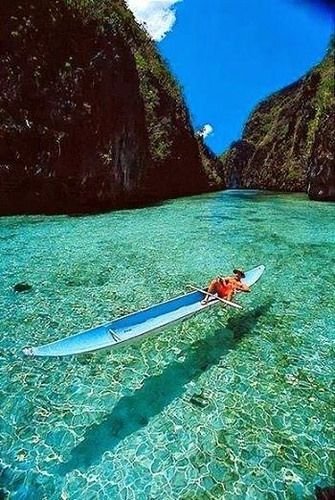
Must-Do Activities
The Philippines is not only about sightseeing but also about engaging in vibrant activities that let you immerse yourself in its natural beauty and culture.
- Island Hopping Tours
Island hopping is a quintessential Filipino experience, especially in Palawan (El Nido and Coron), Cebu, and Siargao. These tours take you to hidden lagoons, secret beaches, snorkeling spots, and dramatic limestone formations, offering endless opportunities for adventure and relaxation.
- Snorkeling and Diving
With some of the world’s richest marine biodiversity, the Philippines is a diver’s paradise. Popular dive sites include Tubbataha Reefs, Apo Reef, and the coral gardens around Palawan and Cebu. Snorkeling is equally rewarding, with vibrant coral reefs and colorful fish easily accessible from many beaches.
- Surfing in Siargao
Siargao’s Cloud 9 break is famous worldwide for surfing. Whether you are a beginner or a pro, there are surf schools and rental shops to get you started. Even non-surfers can enjoy the island’s relaxed vibe, lagoons, and natural pools.
- Trekking and Hiking
Explore the Banaue Rice Terraces and nearby villages on foot to experience indigenous culture and stunning landscapes. Other trekking options include Mount Pulag, the country’s third-highest peak, and the trails around Taal Volcano.
- Visit Historical Sites
Walk through Intramuros in Manila, visit Fort Santiago, and explore colonial churches like San Agustin Church. These sites offer a deep dive into the Philippines’ rich history and heritage.
- Experience Filipino Festivals
Time your visit to coincide with vibrant festivals such as Sinulog in Cebu, Ati-Atihan in Aklan, or Pahiyas in Lucban. These colorful celebrations feature street dancing, traditional music, and elaborate costumes, showcasing Filipino culture at its liveliest.
- Food Tripping and Night Markets
Sample authentic Filipino cuisine from street food stalls and night markets. Try local delicacies like lechon (roasted pig), balut (fertilized duck egg), and halo-halo (shaved ice dessert). Cities like Manila and Cebu have bustling night markets perfect for food lovers.
- Kayaking and Paddleboarding
In places like El Nido and Coron, kayaking through lagoons and mangroves offers a peaceful way to explore the stunning scenery. Paddleboarding is also popular on calm beaches like Boracay’s White Beach.
- Whale Shark Watching in Oslob
For a unique wildlife encounter, swim alongside gentle whale sharks in Oslob, Cebu. This responsible tourism activity allows close encounters with these magnificent creatures in their natural habitat.
- Relax on Secluded Beaches
Beyond the popular spots, the Philippines has countless lesser-known beaches such as Napcan Beach in El Nido and Puka Shell Beach in Boracay. These tranquil escapes are perfect for unwinding away from the crowds.
The Philippines in 2025 offers a perfect blend of natural beauty, cultural richness, and thrilling activities. Whether you are exploring ancient rice terraces, diving in vibrant coral reefs, or simply soaking up the sun on powdery white sands, the country invites you to create unforgettable memories in its warm and welcoming islands. Pack your bags and prepare to discover the diverse wonders of this tropical paradise.
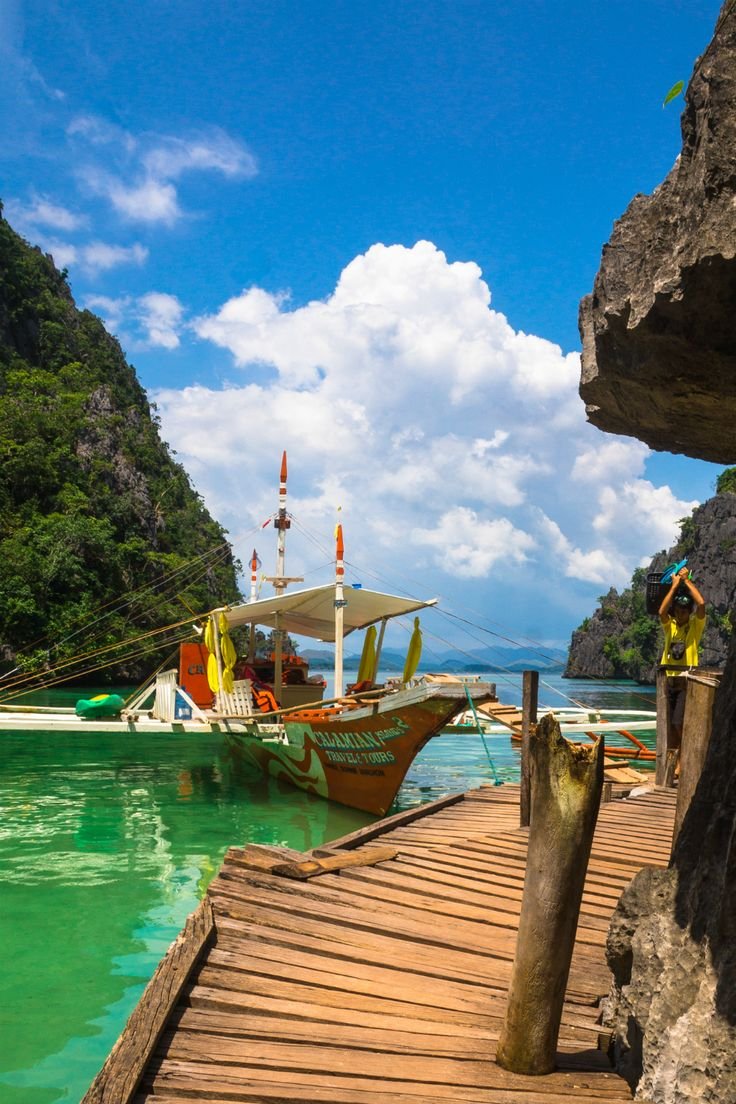
Travel Tips
Traveling to the Philippines in 2025 offers a rich and rewarding experience filled with stunning landscapes, vibrant culture, and warm hospitality. To make the most of your trip, it’s essential to be well-prepared with practical travel tips, especially regarding safety, local customs, and language basics. Here’s a detailed guide to help you navigate the country confidently and respectfully.
Safety Advice
General Safety Precautions
The Philippines is a beautiful country, but travelers should exercise a high degree of caution due to risks related to crime, terrorism, and civil unrest in certain areas. While many popular tourist destinations are generally safe, some regions, particularly parts of Mindanao, the Sulu Archipelago, and the Zamboanga Peninsula, have heightened security risks including terrorism, kidnapping, and piracy. It is strongly advised to avoid travel to these high-risk areas altogether.
In urban centers like Manila and Cebu, petty crime such as pickpocketing and bag snatching can occur, especially in crowded places like markets, bus terminals, and public transport. To minimize risk, avoid displaying cash, expensive jewelry, or smartphones openly in public. Use a crossbody or anti-theft bag rather than a backpack, and keep your belongings close and secure at all times6.
Transportation Safety
Public transportation in the Philippines can be unreliable and sometimes unsafe. Jeepneys and buses are often overcrowded and poorly maintained, and incidents of theft or armed robbery have been reported. If you use jeepneys or buses, remain vigilant, keep your valuables secure, and avoid traveling late at night.
Motorcycle taxis, known locally as habal-habal, are common but considered unsafe and illegal in many areas. It is best to avoid riding on these. Tricycles, another popular mode of transport, are safer but may not have meters and can be in poor condition. Always agree on the fare before your trip to avoid being overcharged.
For taxis, avoid hailing one on the street. Instead, use official airport taxis, hotel-arranged transport, or ride-hailing apps like Grab, which are safer and more reliable. Always insist that the meter is turned on, keep the doors locked, and do not share taxis with strangers. Record the taxi’s license plate number and share it with someone you trust for added security.
If you plan to drive, be aware that road conditions can be poor, and traffic laws are not always strictly enforced. Avoid driving at night or in bad weather, always wear seatbelts, and ensure you have proper insurance and an International Driving Permit if required.
Maritime Travel
Ferry travel is common for island hopping but carries risks due to overcrowding and poor maintenance of some vessels. Accidents increase during the rainy season (June to December) when storms develop rapidly. Always choose reputable ferry operators, avoid boarding overloaded boats, ensure access to life jackets, and plan for possible delays during stormy weather.
Emergency Contacts
- Dial 911 for fire, rescue, or medical emergencies.
- Dial 117 to reach the Police National Operations Center.
- Contact the nearest Philippine National Police (PNP) station if needed.
Health and Insurance
Medical facilities are available in major cities, but emergency response times and quality of care may be limited in rural areas. It is highly recommended to have comprehensive travel insurance that includes medical evacuation coverage. If engaging in adventure activities like scuba diving, ensure operators follow safety standards and use proper equipment.
Local Customs
Respect and Hospitality
Filipinos are known for their warmth and hospitality. A friendly smile and polite greetings go a long way. When entering homes or religious sites, it is customary to remove your shoes. Dress modestly when visiting churches or rural areas.
Social Etiquette
- Address elders and strangers with respect, using titles like “Manong” or “Manang” (older brother/sister) or “Kuya” and “Ate” (older brother/sister) as a sign of respect.
- Avoid public displays of anger or confrontation as Filipinos value harmony and politeness.
- When dining, it is polite to wait for the eldest person to start eating before you begin.
Tipping
Tipping is not mandatory but appreciated in restaurants, hotels, and by drivers or guides. A tip of around 10% is customary if service charge is not included.
Festivals and Traditions
Participating in local festivals is a wonderful way to experience Filipino culture. Be respectful of religious and cultural practices, dress appropriately, and ask permission before photographing people, especially during sacred ceremonies.
Language Basics
The Philippines has over 170 languages and dialects, but the two official languages are Filipino (based on Tagalog) and English. English is widely spoken, especially in urban areas, tourist destinations, and among younger Filipinos, making communication relatively easy for English-speaking travelers.
Common Filipino Phrases
- Hello – Kamusta (kah-moo-stah)
- Thank you – Salamat (sah-lah-mat)
- Yes – Oo (oh-oh)
- No – Hindi (hin-dee)
- Please – Pakiusap (pah-kee-oo-sap)
- Excuse me / Sorry – Paumanhin (pah-oo-mahn-heen)
- How much? – Magkano? (mag-kah-no)
- Where is…? – Saan ang…? (sah-ahn ang)
- Help! – Tulong! (too-long)
Using simple Filipino greetings and phrases is appreciated by locals and can enhance your travel experience.
Non-Verbal Communication
Filipinos often use a subtle nod or a slight smile to say “yes” or “no,” and pointing with the lips is common for indicating direction. Avoid pointing with your finger as it can be considered rude.
Final Thoughts
Traveling safely and respectfully in the Philippines in 2025 means staying informed and vigilant. Avoid high-risk areas, use trusted transportation options, and keep your belongings secure. Embrace local customs by showing respect and politeness, and learn basic Filipino phrases to connect with locals. With these tips, you can enjoy the warmth, beauty, and rich culture of the Philippines while ensuring a smooth and memorable journey.

